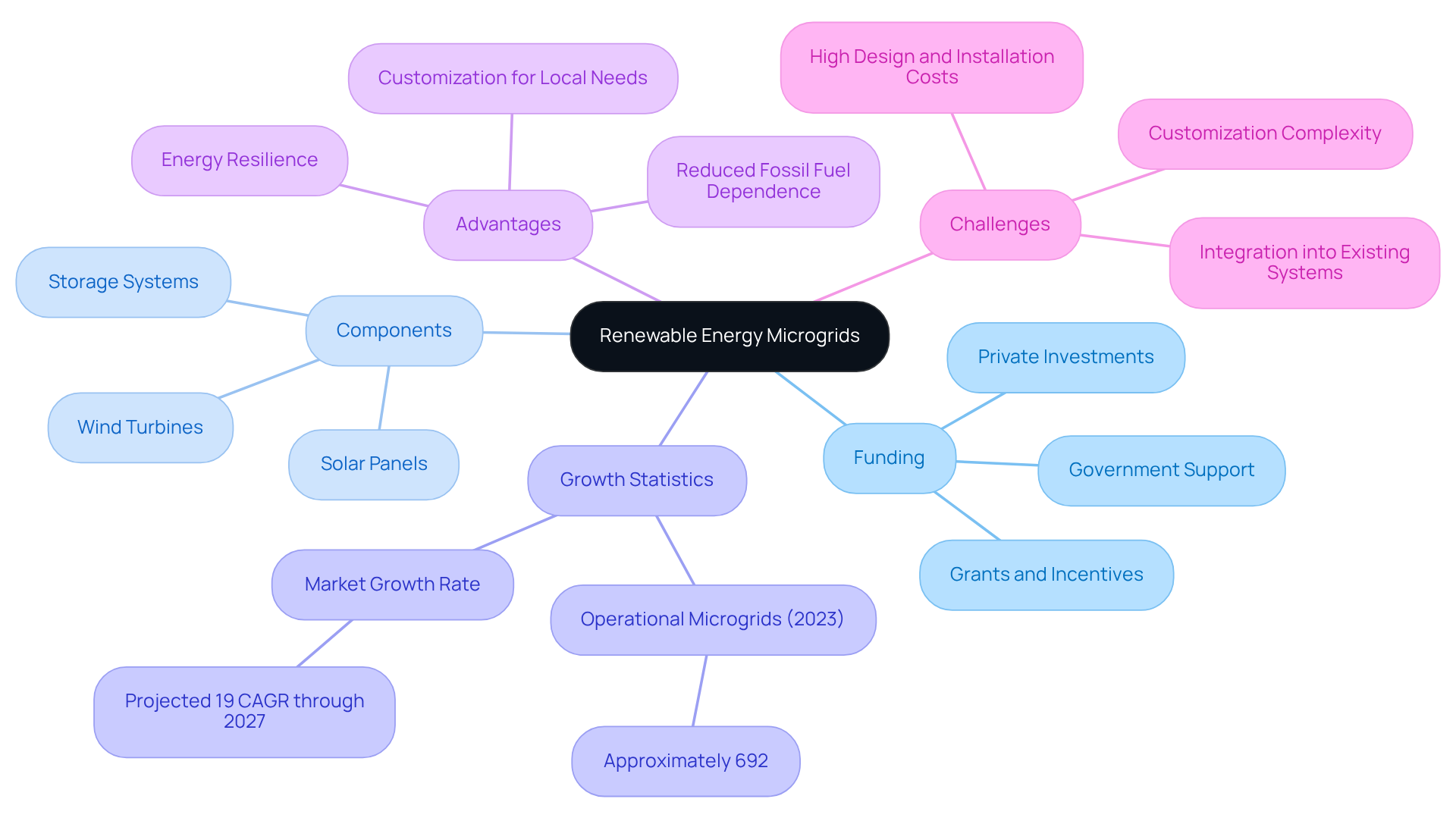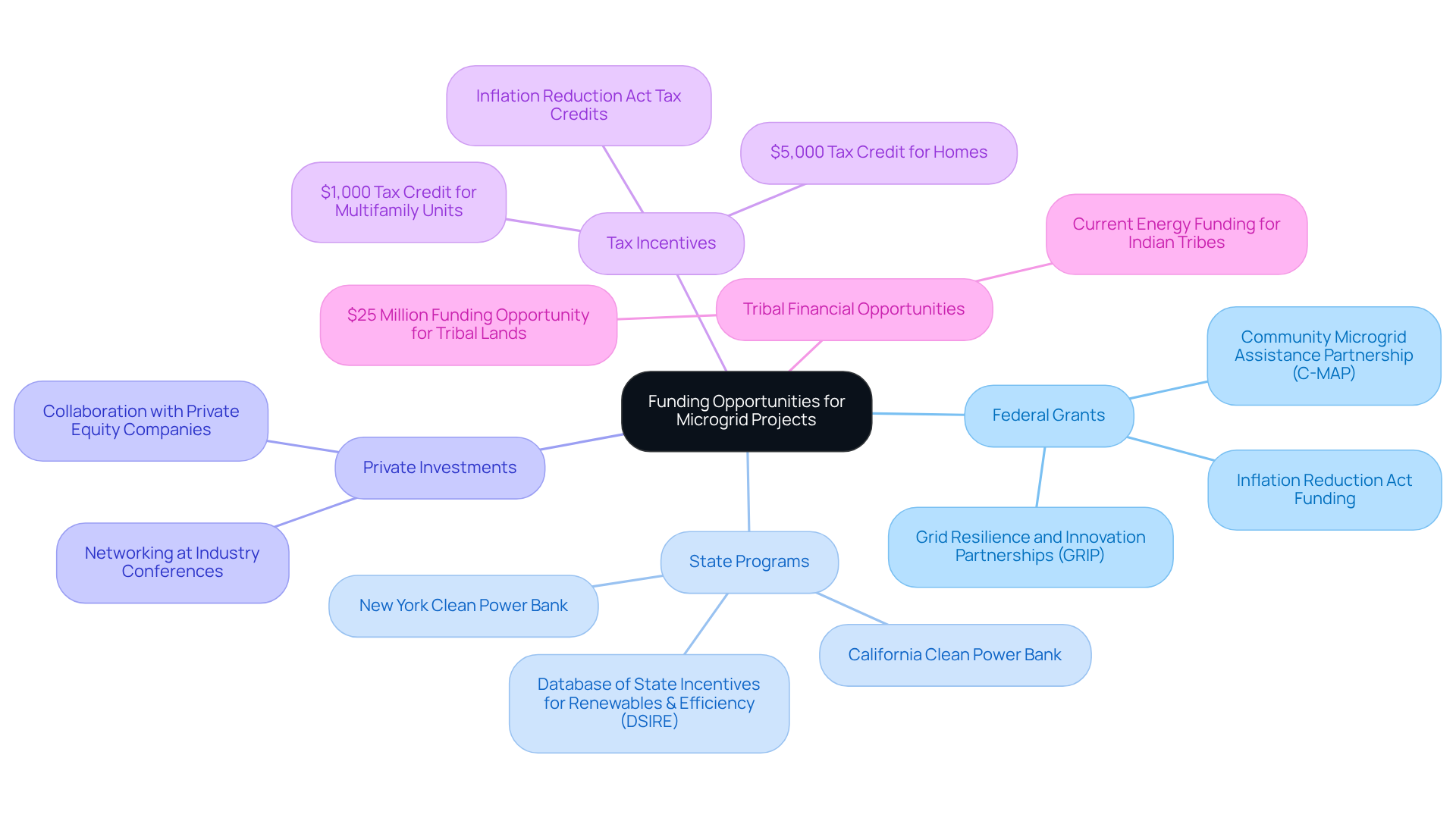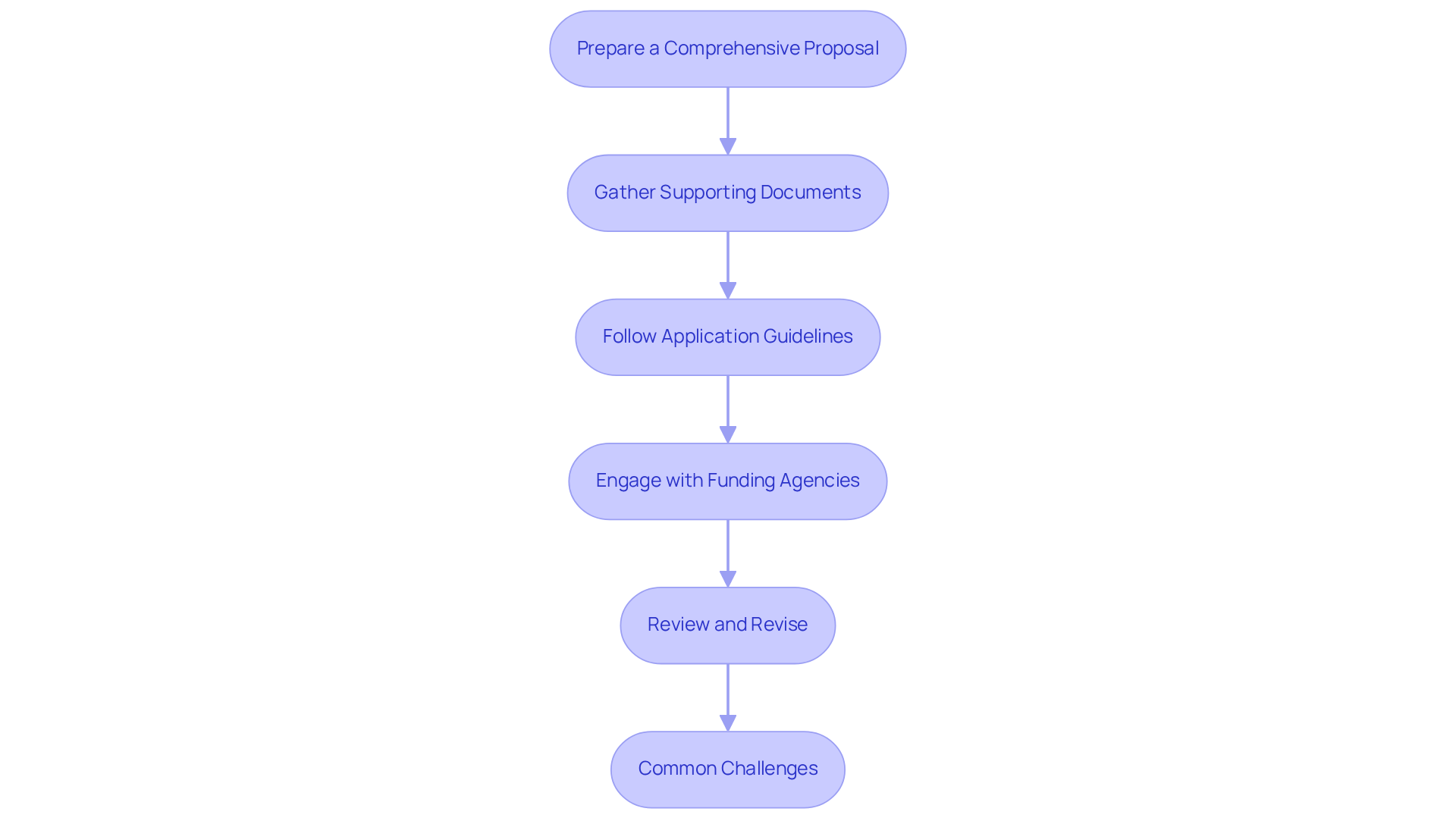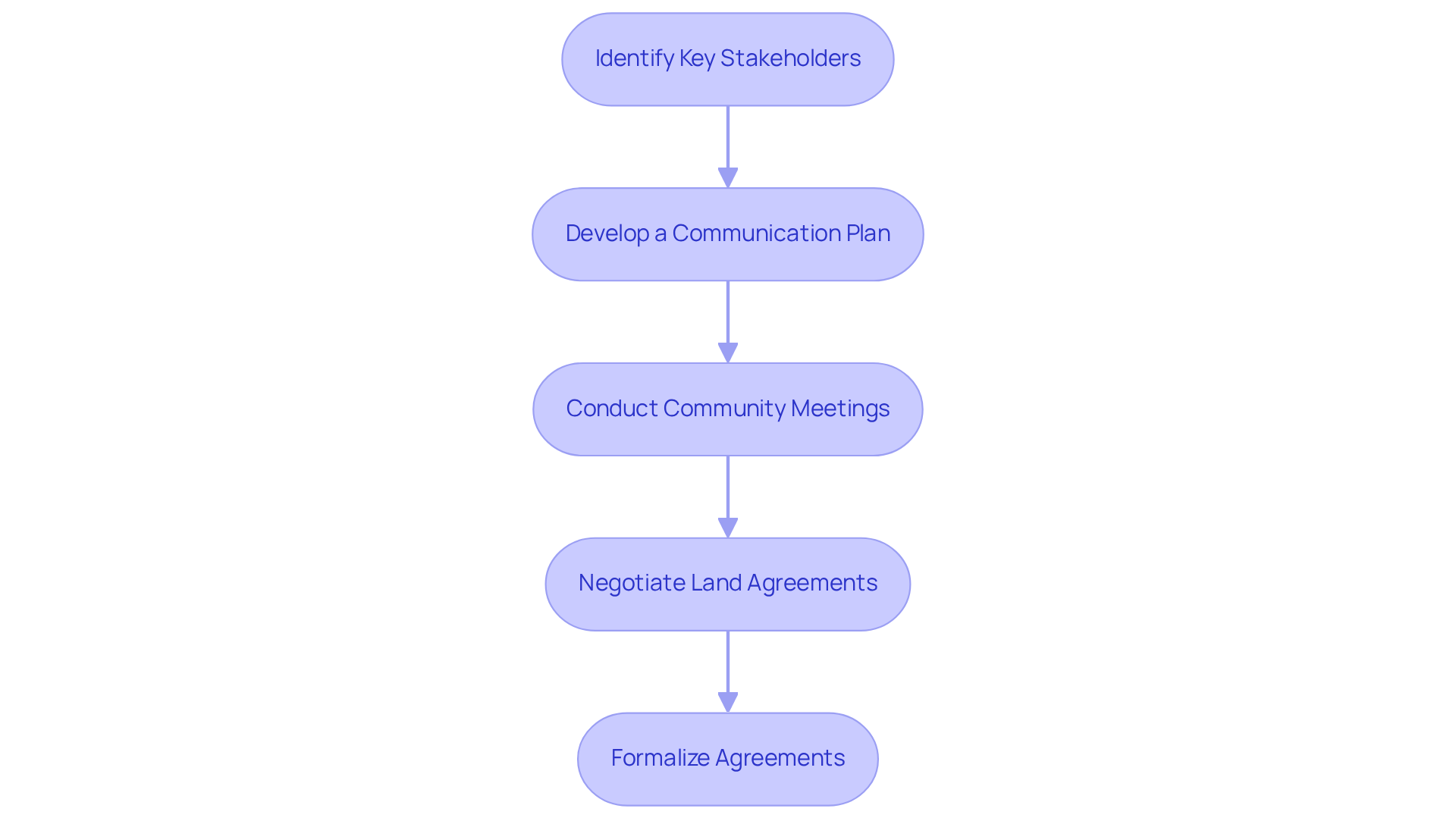Overview
Successfully acquiring funding for renewable energy microgrids requires a strategic approach that identifies various funding sources, prepares comprehensive proposals, and engages stakeholders effectively. The complexities of securing financial support can be daunting. By exploring federal and state grants, private investments, and tax incentives, stakeholders can enhance their chances of approval.
Thorough preparation and active community involvement play pivotal roles in this process. Understanding these essential steps not only increases the likelihood of funding success but also fosters a collaborative environment that benefits all parties involved.
Introduction
Renewable energy microgrids signify a transformative shift in how communities can sustainably harness power, providing a localized solution that can operate independently or in conjunction with traditional energy grids. As the demand for reliable and resilient energy sources escalates, understanding the intricacies of funding these innovative systems becomes essential for developers.
With a multitude of funding avenues available—from federal grants to private investments—how can one effectively navigate the complexities of securing financial support for microgrid projects?
This guide explores the critical steps and strategies for successfully acquiring renewable energy microgrid funding, ensuring that initiatives not only address local energy needs but also contribute to broader sustainability goals.
Understand Renewable Energy Microgrids
Renewable energy microgrid funding supports the development of a localized system capable of operating autonomously or in conjunction with the traditional grid. These systems typically combine various renewable power sources, such as solar panels, wind turbines, and storage systems, to deliver reliable electricity to specific areas, facilitated by renewable energy microgrid funding. By reducing dependence on fossil fuels, renewable energy microgrid funding significantly enhances power resilience and can be customized to meet local power needs. Furthermore, renewable energy microgrid funding can be configured to prioritize renewable power sources over non-renewable ones, thereby bolstering sustainability efforts.
As of early 2023, approximately 692 microgrids were operational in the United States, with the market projected to expand at an average annual rate of 19% through 2027. This growth is driven by escalating electricity costs and the increasing demand for dependable power solutions, particularly in regions vulnerable to severe weather events. However, the highly tailored nature of microgrids poses challenges for large-scale integration into existing power systems.
Understanding the operational principles and advantages of microgrids is crucial for making informed decisions during the resource acquisition process. This knowledge ensures that initiatives align with sustainability objectives and local power requirements.

Identify Funding Opportunities for Microgrid Projects
To effectively finance a renewable energy initiative, it is essential to explore various opportunities for renewable energy microgrid funding. Key sources include:
-
Federal Grants: Initiatives such as the Community Microgrid Assistance Partnership (C-MAP) and the Grid Resilience and Innovation Partnerships (GRIP) provide significant financial support for renewable energy microgrid funding. Regularly check the Department of Energy's website for the latest grant announcements, as these programs can cover up to 75 percent of total eligible project costs. Anticipated awards from the planned notice of funding opportunity are expected to range from $100,000 to $2.5 million or from $250,000 to $5 million, depending on the area of interest.
-
State Programs: Numerous states have developed grant programs specifically aimed at supporting renewable resource initiatives. For example, California and New York run clean power banks that provide renewable energy microgrid funding, enhancing local resilience and sustainability. Additionally, the Database of State Incentives for Renewables & Efficiency (DSIRE) can be a valuable resource for exploring state policies and financial incentives.
-
Private Investments: Collaborating with private equity companies and impact investors focused on sustainable resources can be a beneficial approach. Networking at industry conferences and events can facilitate connections with potential investors who are eager to support innovative power solutions.
-
Tax Incentives: Take advantage of tax incentives offered by the Inflation Reduction Act, which designates more than $370 billion for clean initiatives. Understanding and utilizing these incentives can significantly enhance your initiative's financial viability, making it more appealing to investors.
-
Tribal Financial Opportunities: A recent notice of intent announced a $25 million financial opportunity for energy technology deployment on Tribal lands, which can be particularly advantageous for initiatives aimed at these communities. Applications for financial assistance will be due approximately 90 days after the announcement of the opportunity is issued.
By strategically recognizing and pursuing these financial paths, developers can improve their likelihood of obtaining the essential resources needed for successful implementation of renewable energy microgrid funding.

Navigate the Application Process for Funding
Successfully navigating the funding application process for microgrid projects requires a strategic approach that encompasses several essential steps:
-
Prepare a Comprehensive Proposal: Clearly articulate your project goals, anticipated outcomes, and the community benefits of the microgrid. Include detailed technical specifications and a well-structured budget to demonstrate feasibility and financial planning. Remember, the grant writing average success rate is lower than you might imagine, so thorough preparation is crucial.
-
Gather Supporting Documents: Compile all necessary documentation, such as environmental assessments, community impact studies, and letters of support from stakeholders. These documents substantiate your proposal and enhance its credibility.
-
Follow Application Guidelines: Each financial source has specific guidelines that must be adhered to. Ensure your application meets these requirements, including formatting, deadlines, and submission methods, to avoid disqualification.
-
Engage with Funding Agencies: Proactively reach out to program officers for clarification on application requirements. As Karen Lee, an Account Executive at Instrumentl, emphasizes, understanding the grant writing process is essential for success. Building a relationship with financial organizations can offer valuable insights and enhance your likelihood of success.
-
Review and Revise: Prior to submission, have multiple stakeholders review your application to identify errors and gather constructive feedback. A polished application not only reflects professionalism but also demonstrates your commitment to detail and quality.
Common Challenges: Be aware of frequent obstacles in applications for renewable energy microgrid funding, such as navigating complex guidelines and ensuring all necessary documentation is in order. Addressing these challenges early can streamline your application process.

Engage Stakeholders and Negotiate Land Acquisition
Engaging stakeholders and negotiating land acquisition are essential for the success of your microgrid initiative. To navigate this process effectively, follow these steps:
-
Identify Key Stakeholders: Recognize who will be impacted by the initiative, including local government officials, community members, and potential investors. Understanding their interests and concerns is critical; initiatives with robust community involvement are more likely to be completed on schedule and within budget.
-
Develop a Communication Plan: Formulate a strategy for ongoing interaction with stakeholders throughout the initiative. Regular updates and transparency can build trust and support. Research indicates that 71% of developers believe that increased community involvement leads to fewer cancellations.
-
Conduct Community Meetings: Organize informational sessions to inform the community about the benefits of the microgrid. Address concerns and collect feedback to strengthen your undertaking. Engaged communities can facilitate quicker approvals, making these meetings vital for success.
-
Negotiate Land Agreements: Approach landowners with a well-defined proposal that highlights the advantages of the microgrid. Be ready to discuss compensation and address any legal or regulatory requirements. Successful negotiations often hinge on demonstrating how the initiative aligns with community interests and needs.
-
Formalize Agreements: After negotiations conclude, ensure that all agreements are documented and legally binding. This protects both parties and establishes a clear framework for project execution, minimizing the risk of future disputes and delays.

Conclusion
Renewable energy microgrids stand as a pivotal solution for achieving energy independence and sustainability. They empower communities to utilize local resources effectively while reducing dependence on fossil fuels. Securing funding for these initiatives is not just beneficial; it is essential for the development of resilient and efficient energy systems that cater to specific local needs. A comprehensive understanding of the funding landscape and the application process can significantly bolster the chances of project success.
This article delineates several critical strategies for obtaining funding. These include:
- Exploring federal and state grants
- Leveraging private investments
- Capitalizing on tax incentives
It underscores the necessity of meticulous preparation in crafting persuasive proposals, assembling required documentation, and engaging with stakeholders throughout the process. By tackling common challenges and promoting community involvement, developers can establish a robust foundation for their projects, ultimately facilitating successful implementation.
As the demand for renewable energy solutions escalates, the importance of microgrid funding becomes increasingly evident. By proactively seeking financial resources and fostering community engagement, stakeholders can pave the way for innovative energy solutions that not only fulfill local needs but also advance broader sustainability objectives. Embracing these strategies will enhance project viability and contribute to a more resilient and sustainable energy future for all.
Frequently Asked Questions
What is a renewable energy microgrid?
A renewable energy microgrid is a localized energy system that can operate independently or alongside the traditional power grid, combining various renewable power sources like solar panels and wind turbines to provide reliable electricity.
What are the benefits of renewable energy microgrid funding?
Renewable energy microgrid funding supports the development of systems that reduce dependence on fossil fuels, enhance power resilience, can be customized for local needs, and prioritize renewable energy sources, thereby promoting sustainability.
How many microgrids are currently operational in the United States?
As of early 2023, approximately 692 microgrids were operational in the United States.
What is the projected growth rate of the microgrid market?
The microgrid market is projected to expand at an average annual rate of 19% through 2027.
What factors are driving the growth of renewable energy microgrids?
The growth is driven by rising electricity costs and the increasing demand for reliable power solutions, especially in areas prone to severe weather events.
What challenges do microgrids face in terms of integration?
The highly tailored nature of microgrids presents challenges for large-scale integration into existing power systems.
Why is it important to understand the operational principles of microgrids?
Understanding the operational principles and advantages of microgrids is crucial for making informed decisions during resource acquisition, ensuring alignment with sustainability objectives and local power requirements.
List of Sources
- Understand Renewable Energy Microgrids
- US microgrid market to grow 19% annually through 2027, Wood Mackenzie projects (https://utilitydive.com/news/us-microgrid-market-wood-mackenzie/642341)
- U.S. microgrid additions 2013-2020| Statista (https://statista.com/statistics/748218/us-microgrid-additions)
- Microgrids: Empowering Communities and Enhancing Resilience (https://unity.edu/distance-education-blogs/microgrids)
- U.S. microgrids: installed capacity 2023| Statista (https://statista.com/statistics/1491628/cumulative-installed-capacity-of-microgrids-us)
- US Microgrid Market Size & Share Growth Analysis | 2034 (https://expertmarketresearch.com/reports/united-states-microgrid-market?srsltid=AfmBOopMc7TmdlZfhlZkR9Wyug3Vg6PjiL5rmGB_OIZQB05_sghxMW2F)
- Identify Funding Opportunities for Microgrid Projects
- Microgrids | Government funding | Eaton (https://eaton.com/us/en-us/company/news-insights/stronger-future/microgrids.html)
- Current Funding Opportunities (https://energy.gov/indianenergy/current-funding-opportunities)
- EERE Funding Opportunities (https://energy.gov/eere/funding/eere-funding-opportunities)
- Federal Funding Programs for Clean Energy Deployment: A Guide for States (https://catf.us/resource/federal-funding-programs-clean-energy-deployment)
- Rural Energy for America Program Renewable Energy Systems & Energy Efficiency Improvement Guaranteed Loans & Grants (https://rd.usda.gov/programs-services/energy-programs/rural-energy-america-program-renewable-energy-systems-energy-efficiency-improvement-guaranteed-loans)
- Navigate the Application Process for Funding
- 35 Grant Statistics for 2025: The Ultimate List (https://instrumentl.com/blog/grant-statistics-and-trends)
- Here are some awesome quotes related to grant management:1. "Grant… | Innocent Butare (https://linkedin.com/posts/innocent-butare-3453aa173_here-are-some-awesome-quotes-related-to-activity-7262172485251465217-TYzm)
- Results | EEA Grants (https://eeagrants.org/results)
- Funding Quotes - 20 quotes on Funding Science Quotes - Dictionary of Science Quotations and Scientist Quotes (https://todayinsci.com/QuotationsCategories/F_Cat/Funding-Quotations.htm)
- Record response to the LIFE 2024 call for proposals (https://cinea.ec.europa.eu/news-events/news/record-response-life-2024-call-proposals-2024-10-01_en)
- Engage Stakeholders and Negotiate Land Acquisition
- 20 Quotes To Get You Inspired For a Renewable Future - Solstice (https://solstice.us/solstice-blog/20-quotes-for-a-renewable-future)
- Stakeholder Engagement Effectiveness Statistics (https://zoetalentsolutions.com/stakeholder-engagement-effectiveness)
- What Statistics Indicate The Impact of Stakeholder Engagement? → Question (https://sustainability-directory.com/question/what-statistics-indicate-the-impact-of-stakeholder-engagement)
- Renewable Energy Companies Need Experienced Help with Community Engagement - MOWER (https://mower.com/news/renewable-energy-companies-need-experienced-help-with-community-engagement)
- What Statistics Indicate the Impact of Community Engagement on Project Success? → Question (https://sustainability-directory.com/question/what-statistics-indicate-the-impact-of-community-engagement-on-project-success)




